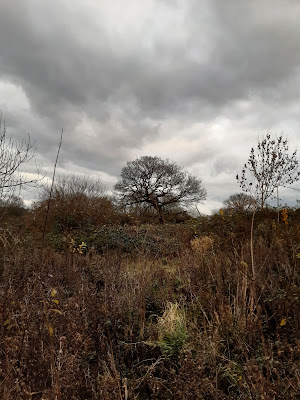An attack of bronchitis is hardly an ideal way to start the New Year, but since I'm holed up at home, I might as well post some photos of where I'm not currently walking a somewhat disconsolate dog.
Autumn was just starting to peter out the last time I posted about the edgelands, so here's a few of its dissolution into winter.
the hollowing oak at its height
bramble leaves the colour of harlequin playing cards
spindle
field maple
through the Small Dark Wood of the Mind
glorious oaklings
the hollowing oak clinging to its colour
the Goat Willow, as yellow with autumn leaves now as it was with catkins in spring
Badger's Bottom
the oak out on the fields
my favourite field maple
dogwood
Charlton Common
next spring's catkins
And then winter. I've already posted about the beautiful frost in mist we had in the first week of December, which had been preceded by a lighter display about ten days earlier.
Floods too. Winter's the time for floods, here in the skylarks' field.
The ditch at the foot of the Field of the Hollowing Oak has had a flow - even a current - for much of December, plus a dam. The poet in me would love to declare Beaver! but there are no nibbled tree stumps and anyhow, they wouldn't live in what is usually just mud. It's just something it built for itself.
Mostly, though, winter's distinguished by its light: soft on cloudy days with barely perceptible shifts of light, or brilliantly delineated in full sun ...
... and its beautiful skies. (Stormy, mostly, as it turns out.)
There have been fungi, and a few fading - or headlong - flowers:
Clockwise from top left: meadow waxcaps; fungus on bramble; candlesnuff; fungi on the hollowing oak, including witches butter; turkeytails; oak bracket fungus
Clockwise from top left: bramble blossom and spindle; buttercups; frosted red dead nettle; white dead nettle; ivies; yarrow and hogweed; ragwort; next spring's periwinkle
As for fauna, the roe deer are much in evidence, if only by their hoofprints. One set is conspicuously smaller than the others - hard to know if that's their fawn, which won't be fully grown yet, or muntjac straying into the field, maybe, especially there's all that construction going on near their rumoured stronghold of Charlton Common. All just conjecture on my part, though.
In addition to the nocturnal wanderings of deer, there's been the usual:
a dead shrew
a dead pigeon
a kestrel on the hunt
dive-bombing goldfinches that, if they hadn't been too fast to photograph, would have looked something like this
As for the developement of Brabazon, the hi-vizzers are increasingly visible this side of Fishpool Hill.
A long trench has been dug in the skylarks field, alongside the cutting, stopping just short of the badgers sett. Let's hope it stays that way.
Meanwhile, the footpath has been lost beneath the tracks of heavy plant ...
For weeks there's been chain-sawing going on down in the cutting ...
... with a section of hedgerow removed, maybe to make a walkway to the station once it's reopened.
As a result, the trains are suddenly a lot more visible than they were. I'm reminded - as so often! - of 'Black Beauty', when the colts are sent to a neighbouring farm and a steam train that skirts the meadow they're kept in terrifies them.
Even the footpath was briefly cut off by a black plastic fence, but it soon got trodden down. Nevertheless, I can't help feeling that our days of walking here are effectively over.
Thank goodness for the field and the hollowing oak.






























































No comments:
Post a Comment